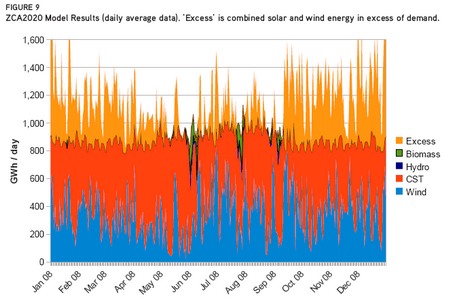Zero Carbon Australia
Posted by Big Gav in australia, beyond zero emissions, renewable energy, zero carbon australia
Phil Hart has a post on the Zero Carbon Australia plan for making Australia's energy supply 100% renewable - Zero Carbon Australia.
The Zero Carbon Australia report attempts to tackle head-on some of the arguments against renewables and to show that they can make much more than a niche contribution to total energy demand. With a target of 100% renewable energy by 2020, clearly this is an ambitious report. While no one suggests this is probable under politics as usual, it shows what might be possible if we are prepared to take a radically new approach.
In the peak oil sphere, there is significant concern about energy return from renewable energy projects. While this report does not explicitly use the term 'Energy Return on Energy Invested' (EROEI), it does provide the numbers for steel and concrete use required to deliver the plan against the current volume of use in Australia. We could get a lot more utility out of those resoures than we do at the moment.Under the ZCA2020 Plan, it is projected that 2020 grid electricity demand will be over 40% higher than today, from 228TWh/yr up to 325TWh/yr. This increase in electricity demand is due largely to the switch of services currently provided by gas and oil to be supplied more efficiently with, renewable electricity. The increase is significantly offset by ambitious but achievable electrical energy efficient targets.
To meet this demand, a combination of wind and solar thermal with storage are proposed as the primary electricity generation technologies. Biomass and hydro are utilised as backup, supplying about 2% of annual electricity.
The ZCA2020 electricity generation mix has been quantitatively modelled in high detail using real-world data, with the results demonstrating that Australia’s electricity demand can be met by 100% renewable energy.
The data underlying the model are derived from real meteorological recordings of solar insolation at the 12 proposed CST sites, real wind speeds at existing wind farms, and grid demand based on actual demand in the National Electricity Market (NEM). Modelling has been performed on a half-hourly timescale for the years 2008 and 2009.
The Plan’s proposed combination of 42.5 GW of CST and 50 GW of wind provides enough energy to cover 98% of the electricity demand modelled, with the remaining 2% being supplied by existing hydro power (5 GW) and heat from biomass co-firing on 10 GW of the CST plants. This is represented by the small green and navy blue areas in Figure 9.






